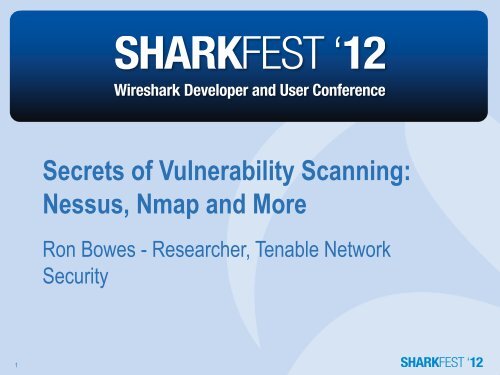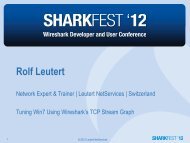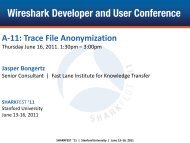Secrets of Vulnerability Scanning: Nessus, Nmap and More - Sharkfest
Secrets of Vulnerability Scanning: Nessus, Nmap and More - Sharkfest
Secrets of Vulnerability Scanning: Nessus, Nmap and More - Sharkfest
You also want an ePaper? Increase the reach of your titles
YUMPU automatically turns print PDFs into web optimized ePapers that Google loves.
1<br />
<strong>Secrets</strong> <strong>of</strong> <strong>Vulnerability</strong> <strong>Scanning</strong>:<br />
<strong>Nessus</strong>, <strong>Nmap</strong> <strong>and</strong> <strong>More</strong><br />
Ron Bowes - Researcher, Tenable Network<br />
Security
2<br />
About me<br />
• Ron Bowes (@iagox86)<br />
– My affiliations (note: I’m here to educate, not sell)
3<br />
SkullSpace Winnipeg<br />
• Winnipeg’s first (<strong>and</strong> only) hackerspace<br />
– Largest <strong>of</strong> its kind in Canada!<br />
• Closely tied to AssentWorks, a makerspace<br />
– Largest <strong>of</strong> its kind in Canada, too!
4<br />
Definitions<br />
• <strong>Vulnerability</strong><br />
• Exploit<br />
• Pro<strong>of</strong> <strong>of</strong> concept<br />
– Safe + Unsafe<br />
• Check<br />
• Scanner
5<br />
<strong>Vulnerability</strong><br />
• A flaw that can lead to a loss in security<br />
– Confidentiality, integrity, or availability<br />
• We’ll look at a bunch <strong>of</strong> examples<br />
– These are all examples <strong>of</strong> checks I’ve written<br />
– Some are fairly obvious attacks, some aren’t
6<br />
Exploits<br />
• Generally the “goal”<br />
– Often code execution
7<br />
Exploits<br />
• Can be simple/safe<br />
– ie, log in with a backdoor username/password<br />
– Authentication bypass (my favourite!)<br />
• Can be difficult/dangerous<br />
– ie, corrupt memory jussssst right to bypass safechecks<br />
<strong>and</strong> execute code<br />
– Much more interesting, but rarely stable
8<br />
Exploits<br />
• Shellcode<br />
– The goal <strong>of</strong> many exploits
9<br />
PoC (Pro<strong>of</strong> <strong>of</strong> Concept)<br />
• Usually a partial exploit<br />
– Frequently a denial <strong>of</strong> service – like fills memory with<br />
\x41 (‘A’)<br />
– Often crashes the service<br />
– Sometimes useful, sometimes not
10<br />
Checks<br />
• Determine if a host is vulnerable<br />
• What they do:<br />
– Check version numbers<br />
– Try <strong>and</strong> produce incorrect behaviour<br />
– Try to run actual code<br />
• How it’s detected depends on the nature <strong>of</strong> the<br />
vulnerability
11<br />
Checks – Safe vs Unsafe<br />
• We generally divide checks into ‘safe’ <strong>and</strong> ‘unsafe’<br />
– Safe checks use version numbers, odd behaviour, or<br />
comm<strong>and</strong> execution<br />
– Unsafe (aka, dangerous, intrusive) checks may damage<br />
the service, congest the network, or cause unwanted<br />
side effects<br />
• Goal is always safe checks<br />
• Sometimes a lot <strong>of</strong> effort goes into making a check<br />
safe
12<br />
Scanner<br />
• A program that performs multiple vulnerability<br />
checks against a host or network<br />
• Eg: <strong>Nessus</strong>, <strong>Nmap</strong>, etc.<br />
• <strong>More</strong> later
13<br />
Who runs vulnerability scanners?<br />
• The Good Guys<br />
– Network administrators<br />
– Security department<br />
– Penetration testers<br />
• Though hopefully they do more than just run tools…
14<br />
Who runs vulnerability scanners?<br />
• The Bad Guys<br />
– Breaking into your sites for fun <strong>and</strong> pr<strong>of</strong>it!<br />
– Many reasons… let’s look at examples
15<br />
Who runs vulnerability scanners?<br />
• The Bad Guys<br />
– Stealing passwords<br />
– Look at the dates �<br />
• This month!<br />
– Diablo 3?<br />
• Item theft = $$$
16<br />
Who runs vulnerability scanners?<br />
• The Bad Guys<br />
– Sending spam<br />
– Ever seen one <strong>of</strong> these?
17<br />
Who runs vulnerability scanners?<br />
• The Bad Guys<br />
– Sending spam<br />
– Do you realize how <strong>of</strong>ten it looks like this?
18<br />
Who runs vulnerability scanners?<br />
• The Bad Guys<br />
– Bots, malware, etc<br />
– This is an example <strong>of</strong><br />
the Blackhole Exploit<br />
Kit
19<br />
Vulnerabilities<br />
• Let’s look at a bunch <strong>of</strong> examples <strong>and</strong> how we detect<br />
them!<br />
– Web<br />
– Overflows<br />
– Memory corruption<br />
– Configuration errors<br />
– Authentication bypass<br />
– Backdoors<br />
– Session hopping<br />
• Note: <strong>Nessus</strong> will detect almost all <strong>of</strong> these (except the<br />
special purpose ones)
20<br />
Web vulnerabilities<br />
• Many types<br />
– Cross-site scripting<br />
– SQL injection<br />
– Cross-site request forgery<br />
• Detection<br />
– Sometimes easy – known issues<br />
– Sometimes difficult – need an inventory, recognize custom<br />
code, custom error pages, etc<br />
• Not going to spend any more time on this<br />
– See: OWASP Top10
21<br />
Overflow vulnerability<br />
• Various types – stack, heap, .data, etc.<br />
– Basically, overwrite variables that shouldn’t be overwritten<br />
– Detection can be easy or hard
22<br />
Overflow vulnerability – Samba<br />
• Infinite loop <strong>of</strong> processing
23<br />
Memory corruption vulnerability<br />
• Typically difficult to detect<br />
– Have to underst<strong>and</strong> exactly what’s going on<br />
– This example is a simplified version <strong>of</strong> ms08-067
24<br />
Configuration errors<br />
• Eg, blank or default passwords<br />
– *cough* Oracle *cough*
25<br />
Configuration errors<br />
• Files on the web servers that shouldn’t be there<br />
– This example is a true story from earlier this month…
26<br />
Backdoors<br />
• Unauthorized way to access the program<br />
• Sometimes called “maintenance hook”<br />
• Can be legitimate (bad) or malicious (worse)<br />
• Generally easy to detect, once it’s known<br />
– Just try to run a comm<strong>and</strong>!
27<br />
Backdoors – legitimate<br />
• Note: being legitimate doesn’t make it right!<br />
– This is from an industrial controller system, <strong>and</strong> are<br />
hardcoded (can’t be changed!)
28<br />
Backdoors – malicious<br />
• Added by somebody evil<br />
– Malicious programmer, somebody who broke in, etc.<br />
– Lots <strong>of</strong> good examples, but this is from vsftpd:<br />
Give access if the password is “:)”
29<br />
Authentication bypass<br />
• Similar to default credentials or backdoor<br />
• Bypass the authentication without credentials<br />
• Typically simple but interesting<br />
– My personal favourite, as you’ll guess by my examples<br />
• Usually easy to detect <strong>and</strong>/or exploit, once you<br />
figure it out
30<br />
Authentication bypass – MySQL<br />
• June 11, 2012 – “Tragic” MySQL vuln
31<br />
Authentication bypass – HP Client<br />
Automation<br />
• I wrote a blog detailing this on skullsecurity.org<br />
• Here’s the logfile:
32<br />
Authentication bypass - Unidata<br />
• I discovered this almost 2 years ago<br />
• It was fixed last month<br />
• https://www.upsploit.com/index.php/advisories/view/<br />
UPS-2012-0012
33<br />
Authentication bypass - Unidata<br />
• Step 1: see what a connection looks like
34<br />
Authentication bypass - Unidata<br />
• Step 2: implement in the most naïve way possible
35<br />
Authentication bypass - Unidata<br />
• Step 3: Skip the part where we sent authentication<br />
– (not shown: change the comm<strong>and</strong> to ‘whoami’)
36<br />
Authentication bypass – security camera<br />
• Step 1: Try to log in
37<br />
Authentication bypass – security camera<br />
• Step 2: Find the error message
38<br />
Authentication bypass – security camera<br />
• Step 3: Find the code
39<br />
Authentication bypass – security camera<br />
• Step 4: Modify the code in memory
40<br />
Authentication bypass – security camera<br />
• Step 5: Try to log in (also, pr<strong>of</strong>it!)
41<br />
Authentication bypass – RealVNC<br />
• A really funny example<br />
• Server: “You may authentication with ‘good’, ‘better’,<br />
or ‘best’ authentication”<br />
• Client: “I choose ‘none’”<br />
• Server: “Welcome!”
42<br />
Session hopping<br />
• Changing to a different session (probably with<br />
higher privileges)<br />
• Lots <strong>of</strong> ways…<br />
– Stealing/guessing a token<br />
– Sessions not invalidated properly (aka, session fixation)<br />
– Etc.<br />
• Often very difficult to detect
43<br />
Session hopping<br />
• A government program<br />
actually did this. I’m<br />
serious. I wish I was<br />
joking.<br />
• (<strong>Nessus</strong> won’t detect<br />
this, nor will any<br />
scanner)
44<br />
Tools<br />
• Let’s start by talking about general concepts<br />
– Enumeration<br />
• Portscanning / web spidering<br />
– <strong>Vulnerability</strong> detection<br />
• False positives / negatives<br />
• Passive vulnerability detection
45<br />
Enumeration<br />
• Portscanning<br />
– Determine which services are available<br />
– Instead <strong>of</strong> running 50,000+ checks against mostly<br />
closed ports, just run the 100 applicable ones<br />
• Web spidering<br />
– Determine which pages <strong>and</strong> arguments exist<br />
– Run tests against all pages + arguments
46<br />
<strong>Vulnerability</strong> detection<br />
• Test for each individual vulnerability on every open<br />
port<br />
• As discussed earlier, several ways<br />
– Get a version number<br />
– Look for interesting responses<br />
– Exploit the vulnerability
47<br />
<strong>Vulnerability</strong> detection<br />
• False positives + false negatives<br />
– Some checks aren’t 100% reliable<br />
– Where do you err?<br />
– <strong>Nessus</strong> has an option: “report paranoia”<br />
– Check vulnerabilities manually!
48<br />
<strong>Vulnerability</strong> detection<br />
• Passive vulnerability scanning
49<br />
Tools<br />
• Going to talk about the tools I’ve been involved with<br />
– <strong>Nessus</strong><br />
– <strong>Nmap</strong><br />
• Tools that also exist that I won’t mention since I’ve<br />
never worked on them:<br />
– Nexpose (Rapid7)<br />
– Burp suite<br />
– Foundstone<br />
– IBM Rational Appscan<br />
– …lots more
50<br />
Tools – <strong>Nessus</strong><br />
• Written by Tenable Network Security<br />
– My current employer<br />
• Oldest tool <strong>of</strong> its kind<br />
– Version 1 was 1997 or so<br />
– Current version is 5.0.1, released earlier this year<br />
– Uses <strong>Nessus</strong> Attack Scripting language – NASL – for<br />
checks
51<br />
Tools – <strong>Nmap</strong><br />
• Originally a portscanner<br />
– Also released in 1997<br />
• Added the “<strong>Nmap</strong> Scripting Engine” a couple years<br />
ago<br />
– Scripts are written in Lua<br />
– Mostly community-contributed <strong>and</strong> Google Summer <strong>of</strong><br />
Code students
52<br />
Tools – bottom line<br />
• Some tools find different issues, <strong>and</strong> have different<br />
strengths<br />
• I personally run three different tools<br />
– <strong>Nmap</strong>, <strong>Nessus</strong>, <strong>and</strong> Burp Suite
53<br />
Tools – output<br />
• You will get false positives <strong>and</strong> false negatives<br />
– Confirming issues is important<br />
• Issues discovered by tools may have the “wrong”<br />
severity ratings<br />
– Underst<strong>and</strong>ing the business <strong>and</strong> triaging issues is<br />
critical
54<br />
Questions?<br />
• Blog: http://www.skullsecurity.org<br />
• Email: ron@skullsecurity.net<br />
• Twitter: @iagox86

















